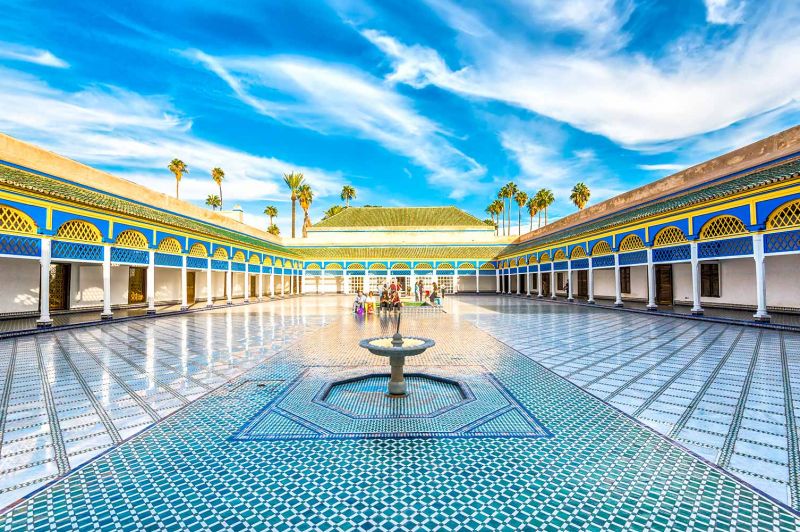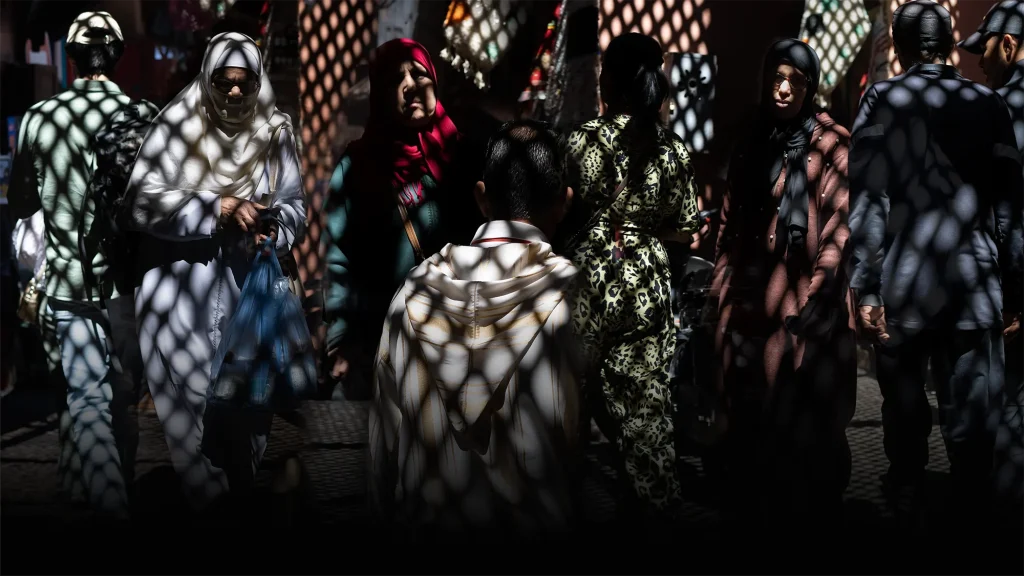This beautiful historical site is a must-see in Marrakech. It’s simple to envision how life must have been two centuries ago in the Bahia Palace. You will see the splendor of Moroccan architecture in all its stunning manifestations.
The Amazing History Of The Bahia Palace
Si Moussa, also known as Mr. Moise in Arabic, was once a slave. He was successful in moving up the ladder to become king chamberlain. He later rose to the position of grand vizier. The northern wing of this enormous castle was constructed by the powerful and affluent Grand Vizier. Between 1866 and 1867, this occurred. The palace is shaped like a huge riad. Nevertheless, it was the biggest, most imposing, and most opulent palace in Morocco at the time. It is close to the Royal Palace of Marrakech, Palais El Badi, Agdal Gardens, and Jemaa el-Fna Square.
Ahmed ben Moussa (1841–1900) was Si Mussa’s son and the Grand Vizir after him. From 1894 until his disappearance in 1900, he ruled Morocco. Ahmed ben Moussa expanded the southern section of this official residence during his rule. He shared a home with his 24 concubines, four formal wives, and numerous offspring. After his favorite wife, the castle is known as Bhiya. It translates to “beautiful” or “brilliant” in Arabic.
The Ahmed Ben Moussa Love Story
The palace’s name carries over the name of the Minister’s wife. The al-Rahmanah tribe is said to be the ancestry of the Bahia. This tribe shares a boundary with the city of Marrakech to the north. And Bahia descended from a clan renowned for its wisdom, glory, and might. Bahia used to go between the family’s riad in Marrakesh and her father’s castle in the Rahamneh region. When the great minister first laid eyes on her, he was still a very young man. After a short while, he asked her to marry him, at which point she became his lifelong companion.
She became the lady of his palaces because of her standing and education. She was his favorite wife and oversaw his household staff. Minister Ahmed bin Musa summoned the best craftspeople from the city of Fez to wow his bride. They spent six years in a row working in the palace. But he passed away in 1890 before finishing the palace’s construction.
Minister Bahá’u’lláh: A Very Dedicated Master
Some testimonies claim that Minister Bahammad had 24 concubines in addition to his four spouses. But because of her extraordinary beauty and depth of education, Bahia was his preferred spouse. There are numerous accounts of the Minister’s great zeal and possessiveness as well. The palace guards were being castrated. This was done to sap their will to rebel against him. But also to stay away from his concubines and spouses. The Bahia Palace employed about 6,000 servants. No one could see his wives or his concubines, except a few blind musicians.
Musa bin Ahmed, the minister’s father, erected the opulent Riyadh and the northern square after the minister passed away. Parts of the palace were finally built by his son Bahammad. But after the minister passed away in 1886, construction was discontinued. After Minister Bahammad passed away, the palace became the home of numerous powerful people. The brother of the Pasha of Marrakech constructed a second storey from 1906 to 1912, which he used as his administrative center. The palace was given a certain configuration by the authorities in 1912.
Wires for telephones, power, and heaters have all been put in place. This suited the new resident, Marshal Hubert Lyautey, the French Resident-General. The palace was designated as a historical monument in the year 1922. Travelers from other countries and locals come to see the Moroccan architecture. especially thinking about the wood engraving.
Photo Tour of Bahia Palace
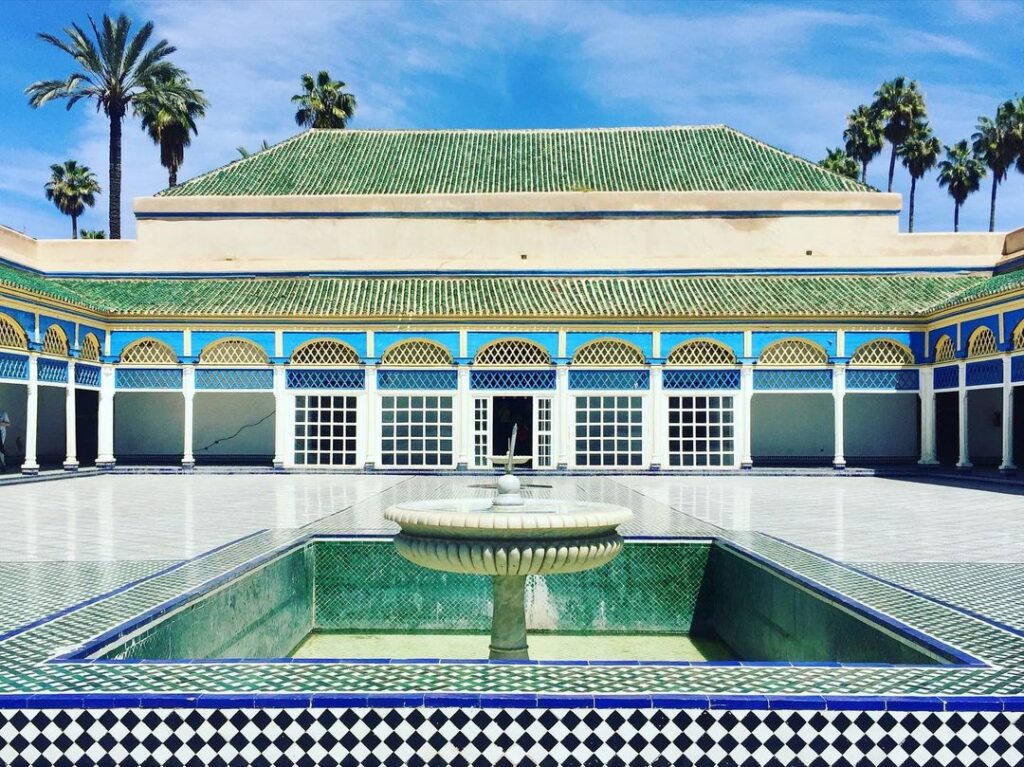
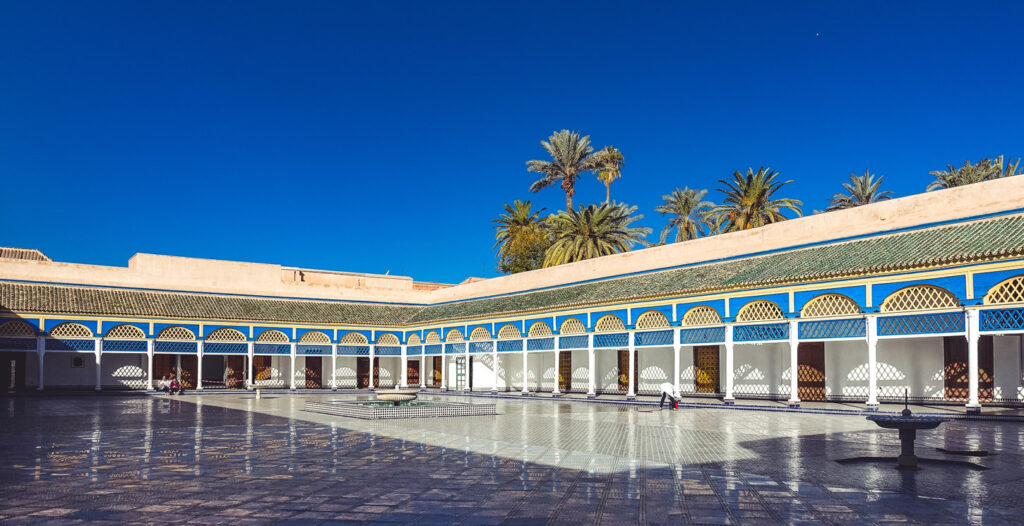
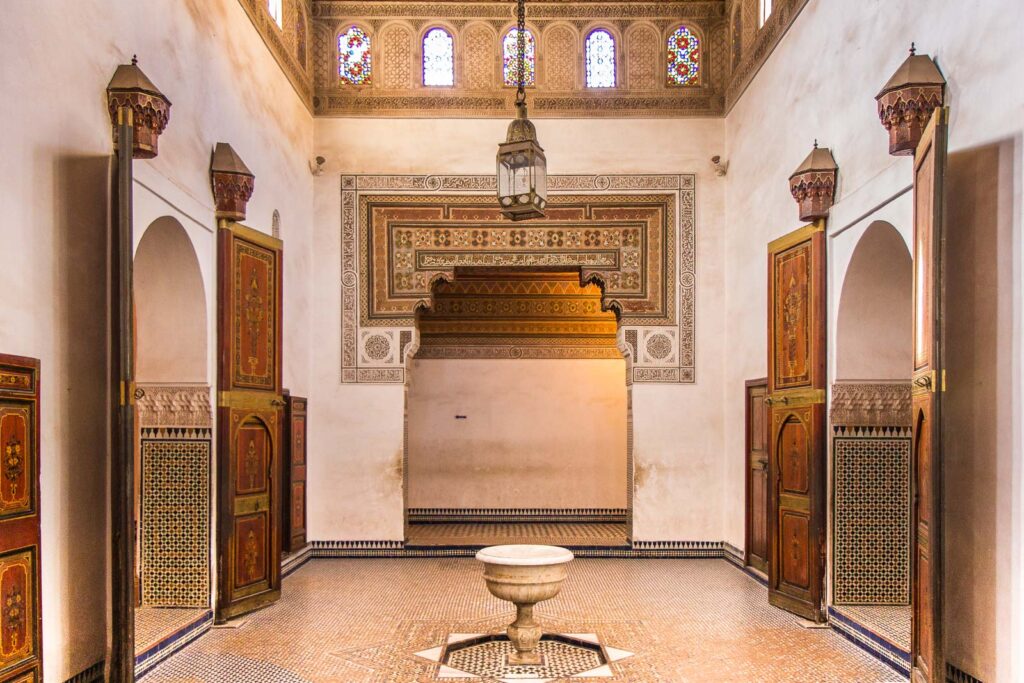
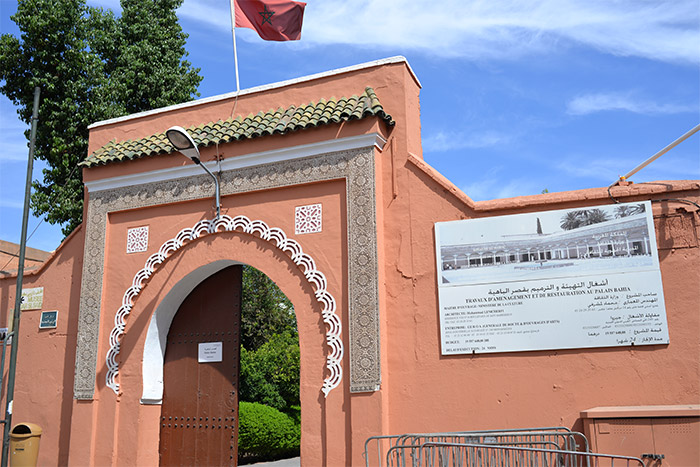


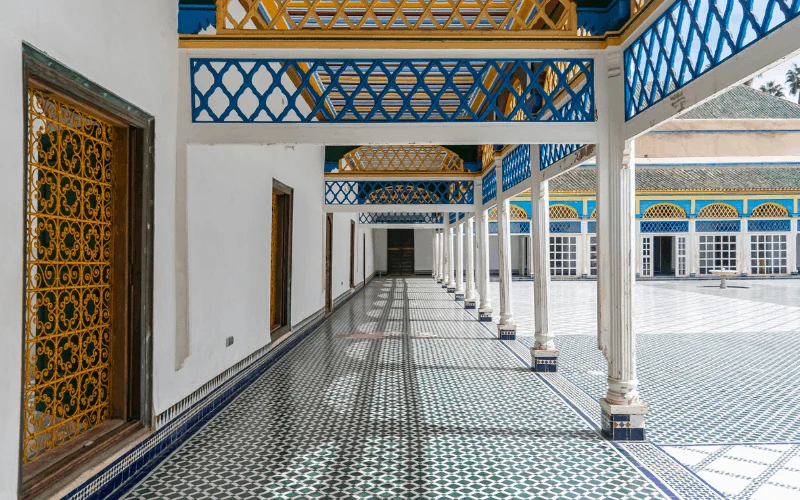
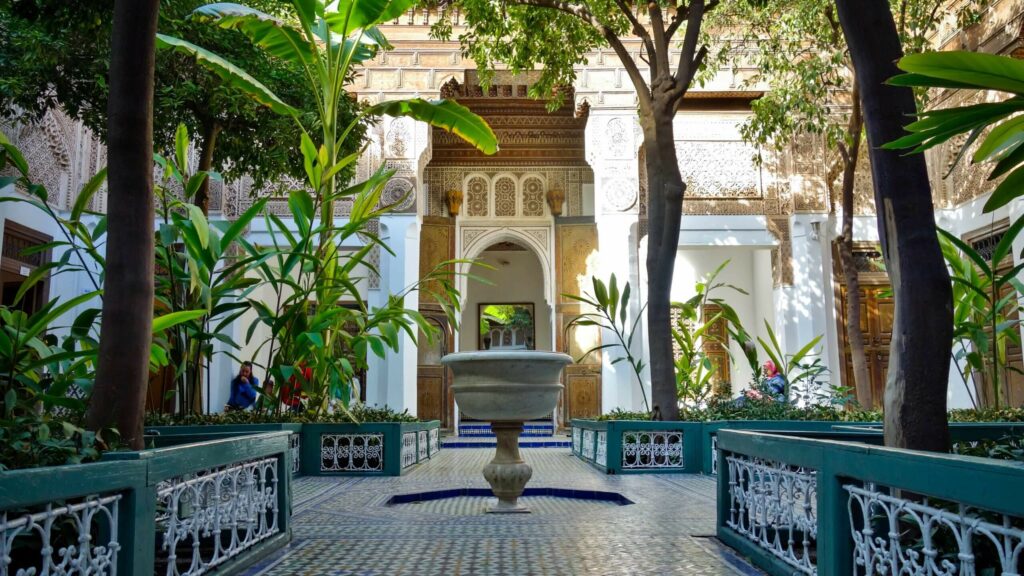
The Bahia Palace’s Amazing Architectural Design
Muhammed bin Makki Al-Messiwi, a Moroccan engineer, oversaw the palace’s construction. In Meknes, he had learned the craft of crafting wood. The palace has a total area of around 22,000 square meters. But it became smaller once several institutions and amenities were built. The expansive garden is located apart from the castle. Additionally, they switched the palace’s primary entrance to a gate close to the Al-Mallah district.
The Mini-Riad
The riad has a lovely garden with four sinks and wide balconies all around it. The Moroccan Zellige-paved pathways of the riad were broken up by a magnificent ceramic fountain. Alongside pavilions are also present on the western side. Three of them have arches made of ornamented cedar wood for their roofs. We are reminded of the old Moroccan architectural style by its design. It is particularly evident in the old schools in Marrakech and Fez.
Southern Gallery
On Ramadan 12, 1315, “this blessed Riad came to an end with the praise of God and his lovely help.” (Compliant with the year 1898). Historical writing may be read on the gypsum friezes above two of the building’s columns. The design of these hallways is incredibly intricate. Outstanding are the vibrant embellishments on the woodwork doors, windows, and ceilings. The French Resident’s office was in the spacious hall from 1956 to 1912. It has two gorgeous foyers and a wooden ceiling that is ornamented. that has holes cut into it to let light in. This riad most likely served as Bahammad’s workplace.
Eastern Square
It is a large courtyard known as the eastern square or the magnificent marble square. It is the most spectacular castle courtyard, encircled by 52 wood-columned corridors. On top of the ruins of Si Musa’s house’s gardens and stable for horses, they constructed the square. The square was flanked by four galleries with wooden columns in an Italian design. This patio was designed with white and green marble pieces, two marble fountains, and ceramic pillars.
Bahia Palace Entry Hours and Ticket Price
Monday through Friday, 9 am to 4:30 pm. On Friday, the admittance hours are 8 am to 5 pm. The entry ticket price is 70 MAD, or roughly $7.
Things to consider Before You Travel
To escape the massive tourist throngs later in the day, go early at 9 or 10 am. There are guided tours offered for the palace. Invest in a guide to inform you about the fascinating tales that aren’t covered in the little notes on each page. Some locals will inform you that the palace is closed today if you approach it from the back. They want to show you additional adjacent areas. This is untrue. You can find the door by continuing to follow the palace walls. The vacant apartments in the palace might disappoint you. The original furnishings are gone. It’s impossible to envision how they lived in this mansion. There are many options for pictures here! Bring your camera, then.
Final Words
The grand vizier of Morocco, Si Moussa, began building this enormous palace in 1866. His son succeeded him as grand vizier and rose to the position of supreme authority in Morocco. He continued to build and embellish this magnificent structure during his lifetime. He gave it the name Bahia after his beloved wife. If you’re in Marrakech, you can visit this monument in less than two hours. You will be admiring the Bahia Palace’s exquisite Islamic architecture.
Bahia palace webpage: https://palaisbahia.com/en/
More posts: https://morocco-phototours.com
Photo themes: https://penzu.com/p/049a5271b45541a1
